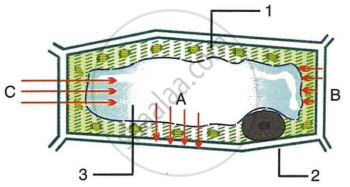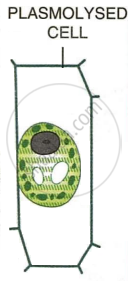Advertisements
Advertisements
प्रश्न
Given below is the figure of a plant cell showing different kinds of pressure acting upon it. Study the figure and answer the questions that follow:

- In the figure, 1, 2 and 3 represent:
- Cytoplasm, Nucleus, Vacuole respectively
- Vacuole, Cytoplasm, Cell wall respectively.
- Cytoplasm, Cell membrane and vacuole respectively.
- Cytoplasm, Cell wall and Vacuole respectively.
- B in the figure represents:
- Osmotic pressure
- Turgor pressure
- Wall pressure
- Diffusion pressure
- A in the figure represents:
- irnbibition pressure
- Wall pressure
- Turgor pressure
- Osmotic pressure
- C in the figure represents:
- Turgor pressure
- Osmotic pressure
- Wall pressure
- Imbibition pressure
- Draw a neat and labelled diagram of a plasmolyzed plant cell.
उत्तर
- iv. Cytoplasm, Cell wall and Vacuole respectively.
- iii. Wall Pressure
- iii. Turgor pressure
- ii. Osmotic pressure

संबंधित प्रश्न
The diagram below represents a process in plants. The setup was placed in bright sunlight. Answer the following questions:

a) Name the physiological process depicted in the diagram.
Why was oil added to the water?
b) When placed in bright sunlight for four hours, what do you observe with regard to the initial and final weight of the plant? Give a suitable reason for your answer
c) What happens to the level of water when this setup is placed in:
- Humid conditions?
- Windy conditions?
d) Mention any three adaptations found in plants to overcome the process mentioned in (i).
e) Explain the term ‘Guttation’.
The state of a cell in which the cell wall is rigid and stretched by the increase in volume due to the absorption of water is called.
Give the equivalent terms for the following:
Loss of water through a cut stem.
Differentiate between the following:
Turgor pressure and wall pressure
Give reason for the following:
A plant cell, when kept in a hypertonic salt solution for about 30 minutes, turns flaccid.
Mention whether the following statement is true (T) or false (F) and give an explanation in support of your answer.
Soaked seeds burst into three seed coats.
Differentiate between the following:
Plasmolysis and Deplasmolysis.
Give Technical Term for the following.
A cell in a fully extended condition.
Excessive use of fertilisers in agricultural fields reduces the yield of crops. Justify the statement.
Addition of salt to pickles is a method of killing the bacteria by ______.
